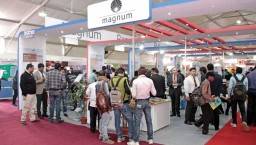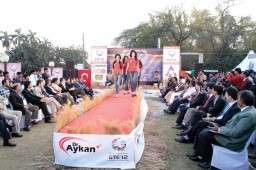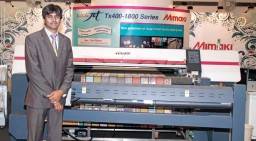
The just concluded GTE 2012, brought together over 600 brands in technology ranging from sewing machines to IT solutions for the garment manufacturing industry, spread out in a covered area of 17,000 sq. ft. for the industry to see, evaluate and discuss technology. With more than 240 booths, the exhibitors over the four-day event were kept busy. A large number of visitors were small entrepreneurs still using old traditional machines and now on the lookout for entry point technology to initiate the process of upgrading units. Smaller centres like Panipat, Indore, Varanasi, Kanpur, Jaipur, Surat and Ludhiana were well represented. This is not to say that garment exporters were completely missing, but the depleted numbers were obvious to all though there was strong visitation from domestic manufacturers from Delhi-NCR region.

While many of the bigger players in the industry gave the fair a miss, many preferred to send their production teams for a review. This is strategically different from what has traditionally been observed with big exporters drawing attention of all the technology providers and adding an excitement quotient to the fair… Over the years exporters like Virender Uppal (Richa Global), Gautam Nair (Matrix Clothing), Sudhir Dhingra (Orient Craft), Lalit Gulati (Modelama Exports), Sandeep Gupta (Gupta Exim) were regular faces at the show, but slowly the number of owners visiting the fair has declined. However, the exporters of the Okhla cluster were seen over the four-day event including names like Akshay Kapur, Radnik; Praveen Nayyar, Dimple Creations; Gunish Jain, Akriti Apparels; Pramod Arora, Flying Fashions; and Amarjit Singh, Indigo Apparels.

So have the bigger players seen enough of technology or has the buying strategy changed. It is indeed a debatable question… Some feel that the bigger players are now regularly visiting international fairs to update on technology and the GTE platform only serves the purpose of middle and smaller players. Yet, many feel that the process of evaluating and buying technology has changed and now though the owner may still be the final decision maker, the initial selection process is done by a professional team of technologists.
With many export companies putting on hold investments earlier planned for 2012, technology providers are turning for support to the domestic market, which many are projecting as a growth segment. Juki has recognized the potential of this huge largely untapped market and has introduced a very basic sewing machine suitable for small enterprises looking for branded machines for quality stitching especially for the Indian market. Over the last three years GTE has seen an increase in the number of visitors from the domestic segment and technology providers too have started displaying products suitable for this market.
[bleft] Mimaki Kanphor launched two new printers for the Indian market, the TS34-1800A inkjet printer and the TS500-1800 transfer sublimation printer. The TS34-1800A prints at the speed of 32 sq. metre/hour in 6-colour mode, while prints at the high speed of 150 sq. metre/hour. [/bleft]
The domestic garment manufacturing industry is a very fragmented and unorganized segment and tapping this market is indeed a task, but at the fair the more proactive manufacturers were present looking for basic single needle machines, some semi-automatic machines for specialized operations like button holing and value adding machines for embroidery and printing. “I already have a successfully running business of saree manufacturing in Banaras and we are now venturing into garment production. Hence GTE is the right platform for me to learn and enlighten myself about this business of garment manufacturing, and I’m looking for everything ranging from sewing machines to CAD/CAM software,” said Mukund Agarwal, Director, G N Exports, Varanasi.
The shortage of labour has forced even small players to seek some automation. A visitor from Rohtak (Haryana) Mahesh Sharma of Babita Garments (‘Fogg’ brand), producing shirts and jeans especially for Haryana market with 50 local machines in his unit was looking to buy 40 single needle lockstitch machines from a ‘good’ brand. According to Mahesh, “We have to use machines giving consistency of quality to minimize downtime.” “I am willing to invest in a machine or attachment which can create ‘borings’ at the armholes in a short time,” added Rohit Sethi who produces T-shirts for the domestic market. Depending totally on job work, Rohit will start his in-house production in a new unit in next one year with an investment of around Rs.1.5 crore.
Many players specializing in lingerie, mainly for the domestic market were also seen at the fair. “The lingerie manufacturing industry is changing drastically and better machines are being used for not only better quality, but also in deskilling the operations to reduce dependency on workers, this has increased the demand for automated solutions,” said V. K. Bajaj, MD, V. K. Bajaj & Co. The company has more than 270 sewing machines and is manufacturing under the brand name of ‘Romance’ and is also supplying to mass retailers like Walmart and Reliance Retail.
For those looking for complete automated solutions, there was very little to see as most brands did not put on display such machines, preferring to promote semi-automatic machines, which they feel is more suited to the Indian market. However, many garment exporters were disappointed. “I came here looking for solutions to reduce labour input, however, there is either very expensive automated machines, which need very skilled labour and have high ROIs or there are a range of specialized semi-automates for different operations which means investment in both labour and machine,” said Aditya Mathur, Akriti Creations, Gurgaon.
Many of the visitors also pointed out that there was no really new technology that inspired them. “Most of the machines which I saw at the fair are already being used by us. There is nothing something special which I can buy for my factory,” said Pradeep Sethi, Director V&S International, Gurgaon. Added Indra Bharadwaj, Vice President-Production, Ritu Kumar, Gurgaon, “I was expecting some innovative and time-saving machines, especially with the features of embroidery and stitching with both operations on it, but there were no such products available.” It cannot be ignored that there is rarely a revolution in sewing technology, what is happening is updates in older versions or innovations in applications, which make the machine more user-friendly and productive.
One section that received great attention was the printing segment with most of the players launching new machines. While Grafica Flextronica showcased their recently launched Nano-printex screen printer which has the ability to print on 14 pallets simultaneously and in 12 different colours and making printing operations exceptionally simple and fast, DCC launched a revolutionary new machine – Atrix GT claimed as the most effective high productivity digital textile printer in the market today. “The confidence of the brand is obvious from the fact that d.gen, the manufacturers of the brand have announced a life time warranty on the machine, which includes even the printing head,” says Dhaval Dadia, MD, DCC.
A market leader, Mimaki Kanphor, launched two new printers for the Indian market – the TS34-1800A inkjet printer and the TS500-1800 transfer sublimation printer. While the TS34-1800A prints at the speed of 32 sq. metre/hour in 6-colour mode and is equipped with the new Piezo staggered print heads and uninterrupted ink supply system, the TS500-1800 transfer sublimation printer prints at the high speed of 150 sq. metre/hour while using the new cost-effective Sb300 sublimation ink. Even the embroidery thread suppliers admitted that the demand for their products was declining as printing and especially digital printing was a major fashion trend globally. “It has also helped that the cost of inks has reduced by almost half, making printing a very viable option,” opined Vinod Krishnamurthy, MD, Mimaki Kanphor.
Another segment of technology that is picking up is flatbed knitting, with suppliers admitting that many companies, including names like Shahi, Orient Craft, Boutique International and FFI investing in flat knitting machines in the last one year. “We have received many visitors looking for automated flat knitting machine, there is no way out as manual and semi-manual options can neither give the productivity nor remove the dependency on labour,” argued Udayan Khanna, MD, T. Khanna & Co.
Among the new exhibitors ATE, a big name in the textile technology industry was present with its many brands. Backed by holistic service to the complete satisfaction of its customers, ATE entered the garment segment about a year ago and is already associated with some of the best technology providers for the segment including Dr Aykan, Yilmak, Monti and Dolphin. “We were very clear on why we wanted to enter the segment and how we intended to do business, and today we don’t have to negotiate for dealerships/partnerships, but companies approach us as they know our background and commitment when representing any company,” said GV Aras, Director, ATE Enterprises.
“There is always something new happening in some segment of technology and regular annual fairs give an opportunity to not only see those developments but also meet customers and develop new markets,” said Ricky Sahni, Jt. MD, GTE. Adding weight to the thought Pavan Kapoor, MD, IIGM said, “GTE has become a national fair and it is important to participate to share views, technology and meet the industry all in one go.”
Accessory Manufacturers Showcase Innovations
While technology was the main focus, there were some accessory suppliers who had some new developments to show. Garment Trims that deals in imported accessories from China was a first time exhibitor and was displaying latest innovations in fancy belts, some of them uniquely made out of artificial stones and crystals. “We also showcased collection of dresses and stoles that are completely made out of lace, such as creative designs in chemical laces and Battern Bourgh laces, launching this product right on time with the raging popularity of the lace trend in apparel all over the world,” said Abhay Jain, Director Garment Trims.
[bleft] Grafica Flextronica showcased their recently launched Nano-printex screen printer, which has the ability to print on 14 pallets simultaneously and in 12 different colours. The printer is in-built with the electric textile dryer Nano-texdryer and the Nano-flashtex, online flash curing unit. [/bleft]
Siliconi Commerciale, represented in India by Rajasthan International was displaying their latest patent technology of a water based adhesive for the garment printing technology, marketed under the name of Takter 1. Amongst the other innovative products was PULIMAK, which is a chlorinate free spot cleaner for machine oil and grease stains, suitable for all types of fabrics with the USP of leaving behind no ring formations or Halos and no bleeding of colour.
Displaying a complete range of sustainable products, J.V. Plastic has come up with a new industrial plastic seal to avoid pilferage of the products while being transported. “These seals are meant for garment containers and trucks to add more security to the entire transportation system. Every seal has a unique code on it which once delivered, can be checked and coordinated from the sender,” said Kapil Lalwani, Director, J.V. Plastic.
Zipper manufacturers were concentrating on varied finishes. Sudip Mukherjee, Director, YKZ Zip Fasteners, Kolkata was focusing on water repellent zippers. “Though GTE is a good platform to make contacts and get buyers, the response this year was less than our expectations created by the response of the previous fair. This time we have focused on our nylon zipper and our new water repellent zipper for shoes.”
T&S Buttons Lanka, was the one company that was completely in line with global trends forecasted to lead fashion in S/S 2013. Investing into some latest machinery to achieve varied looks in buttons, the company has divided their collection into six major themes that are aptly named punk, wood carving, candy land, vintage, rough & tough and fabric covered, which are created by their own design theme. “We are positive about our new ranges, and even though the market is slow overall, we received some enquiries,” said Nagaranjan Kayamboo, Sales Manager – India, T & S Buttons Lanka. The company already supplies to some leading buyers in Europe like Zara, and others like Marks & Spencer, Tesco, Next and GAP.
Dalpat J. Kaswala, Director, Shri Khodal Creation (King Laces brand) was very happy with the response that he got for his new developments. “We have got an overwhelming response in GTE for our new range of ‘cutwork lace’, which we launched 2 months ago. Similarly our ‘designer patches’ has grabbed attention as well, which we launched 6 months back,” he concluded.
[bleft] Taking it as a challenge, Arun Electronics introduced plastic seal tags to the Indian market 10 years ago. Also manufacturing electronics, the company has worked with hundreds of brand in the past decade. [/bleft]
Suvi Fabrics and Linings displayed a ‘needle punch felt’, a non-woven fabric made from polyester fibre for multi-purpose use. “The felt is a breakthrough in textile technology and we have specially imported the machine to manufacture this product, which has application in garments with quilting, bag lining, packaging and even roads,” said Manish Gulati, Director, Suvi Fabrics and Linings.
Being in the garment accessory business for a long time now, K.C. Astir & Co. has always been upbeat with new innovations. This time at the fair, the company displayed a complete collection of micro lace fabrics and lace trims made out of a soft and fine yarn, used in a variety of export garments, especially in ladies-wear apparel products.
[bleft] T&S Buttons Lanka, was the one company that was completely in line with global trends forecasted to lead fashion in S/S 2013, investing into latest machinery to achieve varied looks in buttons. [/bleft]
RST Rayons dealing in viscose filament yarn is promoting their latest developments in embroidery and aari threads.” From producing 400 colours since the very start, the company this year is producing 600 colours, which is one of the highest numbers of shades produced by no other company in India,” said Nikhil Tondon, MD, RST Rayons.
Though accessory suppliers were relatively fewer in number, the range that they represented was intresting for visitors, indeed GTE has become an important platform to showcase innovation.

Post a Comment